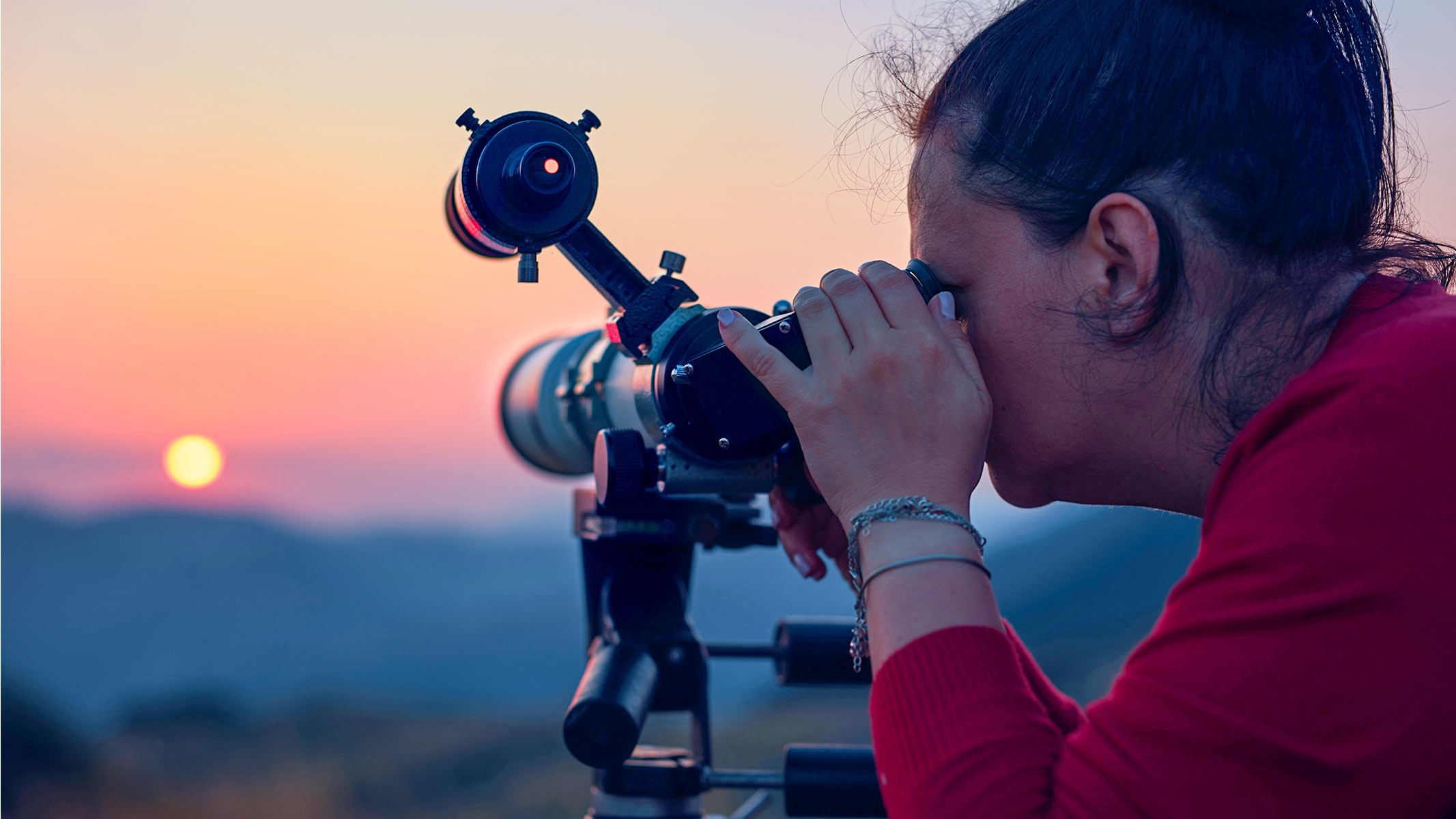
Has March’s partial total eclipse left you craving another solar spectacle? Then you’ll want to be well-equipped for the next solar eclipse, and the same is true if you’re into solar observation. That’s where the best solar telescopes come in.
Why solar telescopes? Because you can’t just reach for a regular, unfiltered telescope. Staring at the sun without protection can cause serious eye damage. NEVER LOOK AT THE SUN WITH THE NAKED EYE, especially through a regular telescope.
Instead, you’ll need a solar telescope with a built-in or attachable filter, one that meets the ISO 12312-2 safety standard. This standard ensures that no more than 0.0032% of the sun’s dangerous rays meet your eyes.
Don’t be tempted to put the best solar telescopes away until the next solar eclipse, either, useful as they may be. The telescopes we’ve selected can be used for regular solar observation as well, and some double up as nighttime scopes. Or if you’re looking for something more portable, we’ve rounded up the best solar binoculars and other solar viewing gear. However, see our main page for the best telescopes overall, to view nebulas, star clusters, galaxies and more.
Solar eclipse gear deals April 2025
- Amazon: Celestron solar eclipse glasses
- Target: Discounted solar eclipse glasses
- Best Buy: Solar glasses, viewers, telescopes and binoculars
- B&H Photo Video: Binoculars, glasses and telescopes
- Adorama: Discounted solar eclipse glasses, binoculars and filters
The quick list
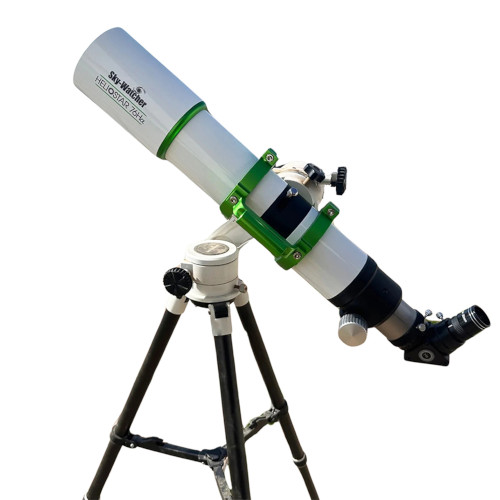
Sky-Watcher Heliostar 76mm Solar Telescope
Best overall
Serious about solar viewing? This is a powerful, flexible solar scope that should be with you for years.
Read more below
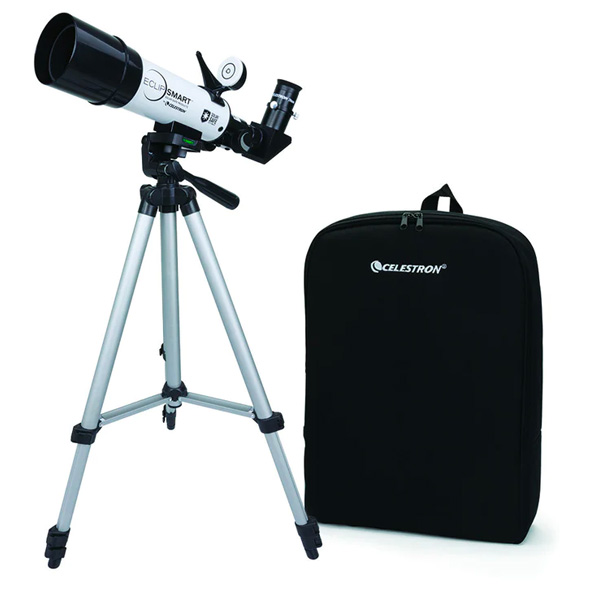
Celestron EclipSmart Travel Solar Scope 50
Best for portability
Want to watch the sun on the go? This scope is super portable and its low price makes it ideal for beginners or those on a budget.
Read more below
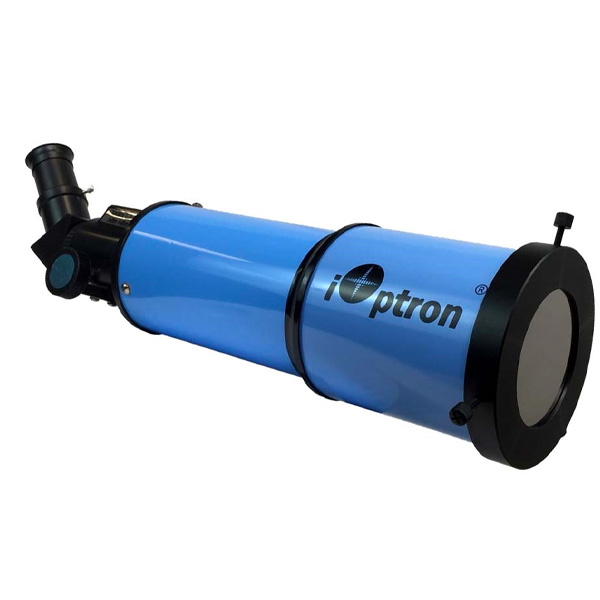
iOptron 80mm White Light Solar Telescope
Best for wide-field viewing
This telescope’s field-of-view and removable filter means you’ll get expansive views of the sky, day or night.
Read more below

Celestron PowerSeeker 127EQ telescope with free EclipSmart Solar Filter
Best for versatility
The PowerSeeker 127EQ is powerful enough to make the most of solar eclipses and its removable filter means you can train it on the night sky.
Read more below
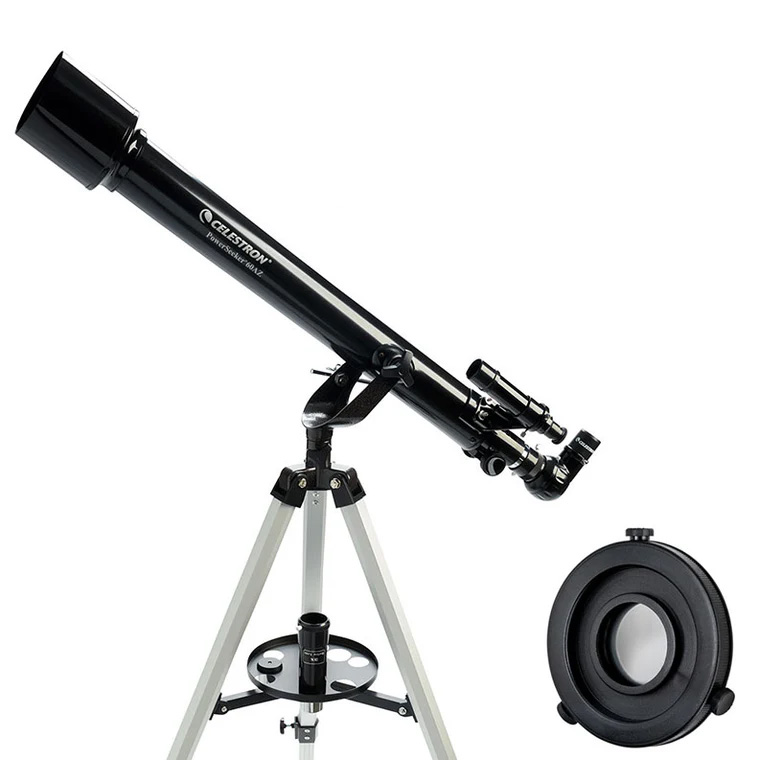
PowerSeeker 60AZ Refractor with free EclipSmart solar filter
Best budget
A good choice for absolute beginners or those on a low budget, and it works equally well as a nighttime or solar telescope.
Read more below
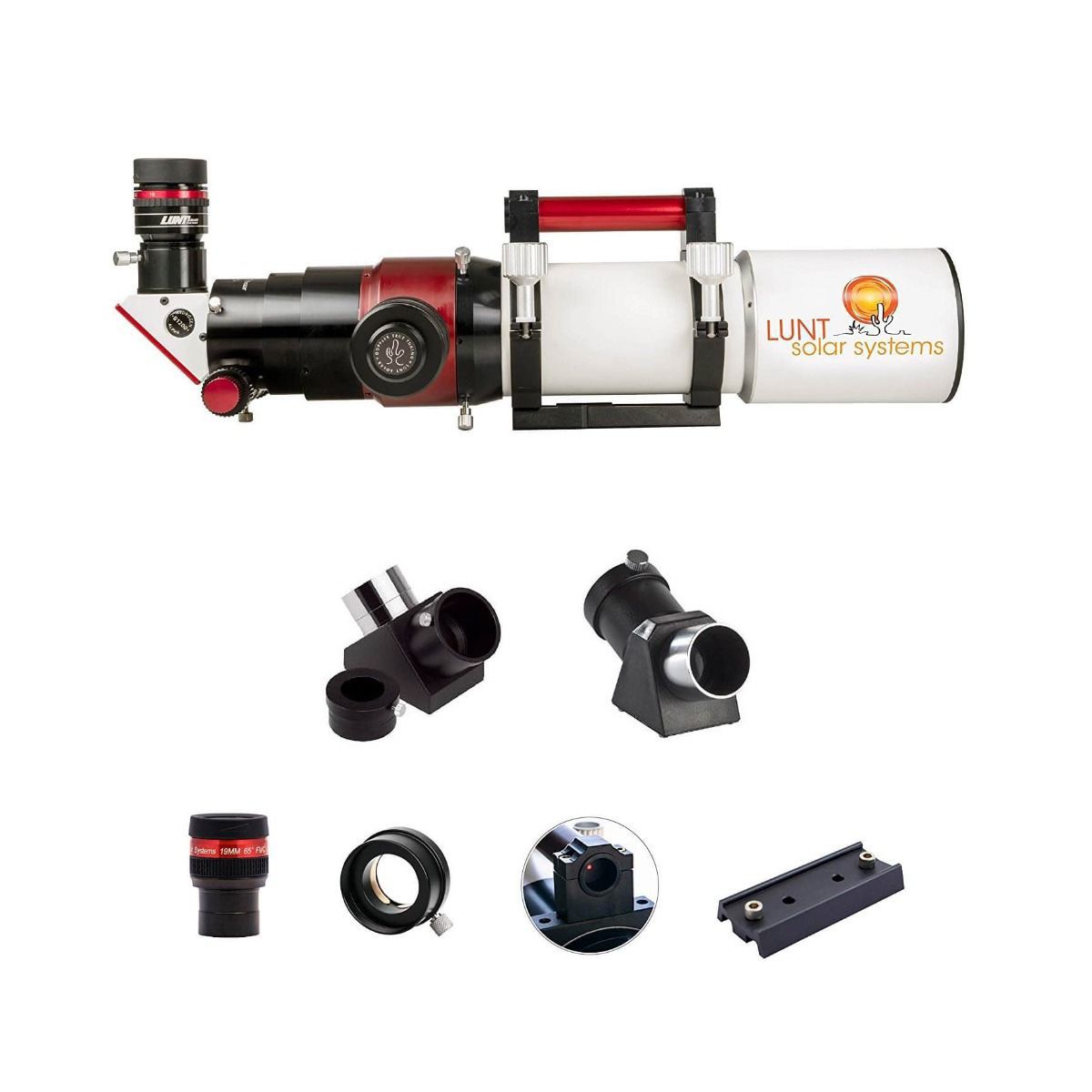
Lunt Solar 80mm f/7 Universal Day & Night Use Modular Telescope
Best premium
This telescope comes with a hefty price tag, but it offers premium performance, both as a solar telescope or a traditional night sky scope.
Read more below
The best solar telescopes we recommend in 2025
Why you can trust Space.com
Our expert reviewers spend hours testing and comparing products and services so you can choose the best for you. Find out more about how we test and review products.
Best overall
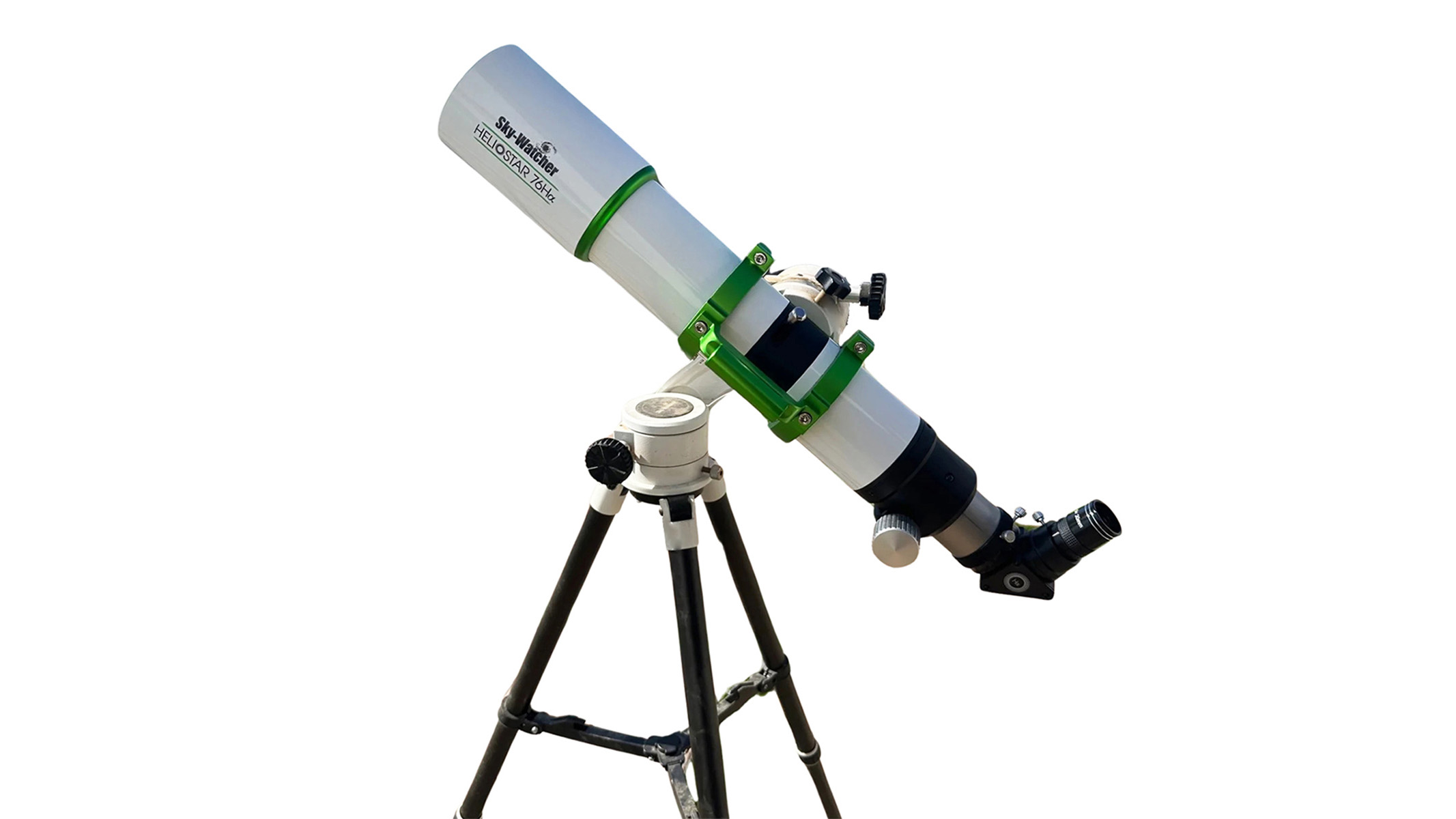
Sky-Watcher Heliostar 76mm Solar Telescope
Best overall: A powerful solar telescope suitable for eclipse watching and general solar viewing
Specifications
Max magnification: 150x
Aperture: 3-inches / 76mm
Focal length: 25-inches / 630mm
Filter type: H-alpha
Eyepieces included: 20mm 70 Degree 1.25″ 32x magnification
Weight: 8.4 lbs (3.81kg) tube
Reasons to buy
+
Powerful
+
H-Filter allows for extra detail
+
Come with solar finder
Reasons to avoid
–
A little expensive for just eclipse-watching
Buy it if
✅ You want to watch the sun on a regular basis: This is a powerful scope that’s suited to solar viewing beyond eclipse watching.
✅ You want detailed views of the sun: This solar scope’s filter allows you to view the sun’s chromosphere.
Don’t buy it if:
❌ You just want to watch eclipses. As powerful as this solar scope is, it’s hard to justify its price tag if you’re only getting it out a couple of times a year.
The bottom line
🔎 Sky-Watcher Heliostar 76mm Solar Telescope: If you’re serious about solar viewing, this is a powerful, flexible solar scope that should be with you for years.
We’ve been seriously impressed by Sky-Watcher’s scopes, awarding the company’s Sky-Watcher 200P EQ5 telescope four and a half stars in our review. You can expect the same quality from the Sky-Watcher Heliostar 76mm Solar Telescope, which is geared towards regular sun-watchers.
It’s a little pricier than some scopes on this list, but it boasts an H-alpha solar filter, which permits viewing of the sun’s chromosphere. This means you may be able to see solar prominences and other surface details, compared to a regular white light filter.
The Sky-Watcher Heliostar 76mm Solar Telescope comes with a solar finder, which should be especially handy when tracking a solar eclipse. This solar telescope also meets the ISO 12312-2 international safety standards, ensuring you can watch eclipses without fear of eye damage.
It comes with a 32x eyepiece, but has a max magnification of 150x in case you want to swap in one of the best eyepieces for telescopes. If you’re a serious sun-watcher, beyond just observing the odd eclipse, this telescope is for you.
- Back to the top ⤴
Best for portability

Best for portability: This handy white-light solar scope is easy to carry or pack away till the next eclipse
Specifications
Max magnification: 118x
Aperture: 2-inches / 50mm
Focal length: 360mm
Filter type: White light
Eyepieces included: 20mm (0.78-inch) Kellner (1.25-inch), 18x magnification
Weight: 2 lbs/918g (total kit)
Reasons to buy
+
Comes with backpack
+
Low price
+
Simple and safe
+
Excellent finderscope
Reasons to avoid
–
Wobbly tripod
–
Plastic build
Buy it if
✅ You want a portable solar telescope: You can transport this solar scope with ease and pack it away for the next eclipse.
✅ You’re on a budget: This solar scope’s price won’t break the bank, ideal if you’re using it infrequently.
Don’t buy it if:
❌ You want to capture images: We found its smartphone image quality lacking.
❌ You want a sturdy scope: We found the tripod slightly wobbly and the scope a little plasticky.
The bottom line
🔎 The Celestron EclipSmart Travel Solar Scope 50 is best suited for eclipse watching on the go and its low price makes it ideal for beginners or those on a budget.
Celestron is one of the leading names in optical technology, and their products regular appear in our guides to the best binoculars and best telescopes. The Celestron EclipSmart Travel Solar Scope 50 may not have the power of the Sky-Watcher Heliostar 76mm, but it’s an excellent little scope if you need portability, and its budget price makes it great for beginners.
We had good things to say about this scope in our EclipSmart Travel Solar Scope 50 review, awarding it four stars. It comes with its own backpack, so eclipse-chasers can just take it on the go, or pack it away until the next eclipse. We were also impressed by its finderscope, which is better than we’d expect for a scope of this price.
It’s super-easy to set up, meaning you can be eclipse-watching in minutes and, thanks to the built-in ISO 12312-2 complying white light filter, your eyes will remain safe. Its tripod could be sturdier, but despite its size, it still offers excellent views of the sun.
- Read our full EclipSmart Travel Solar Scope 50 review
- Back to the top ⤴
Best for wide-field viewing
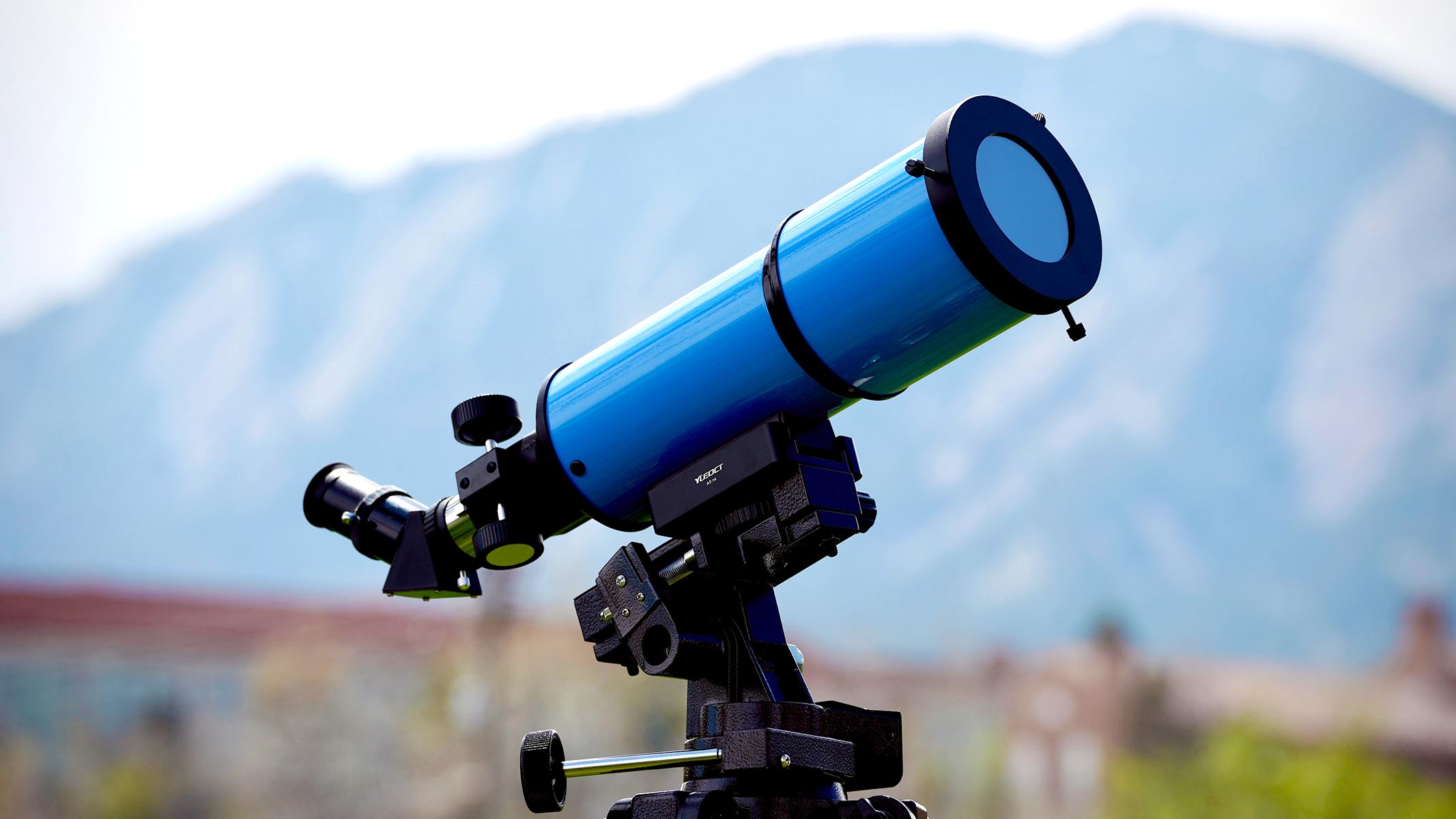
iOptron 80mm White Light Solar Scope
Best for wide-field viewing: Its removable filter also makes it suitable for both eclipse-watching and night time viewing.
Specifications
Max magnification: 189x
Aperture: 3.15-inches / 80mm
Focal length: 16-inches / 400mm
Filter type: SolarLite white light (removable)
Eyepieces included: 25mm (16X), 10mm (44X)
Weight: 3lbs / 1.4kg
Reasons to buy
+
Detachable filter
+
Affordable
+
Works with computerized GoTo mounts
Reasons to avoid
–
Doesn’t include a tripod
Buy it if
✅ You want a versatile scope: You can use this solar scope at night, without its filter.
✅ You’re on a budget: This is solar scope isn’t the absolute best out there, but it offers respectable viewing quality for the money.
Don’t buy it if:
❌ You want a ready-to-go setup: You’ll have to buy a separate tripod to use this telescope as there’s not one included. It’s also not a solar telescope out of the box, but requires attachment of the solar filter.
The bottom line
If you buy one of the best tripods to go with it, the iOptron 80mm White Light Solar Scope is a solid, fairly-priced scope for daytime and nighttime viewing.
Only use this telescope for solar observation once you’ve equipped it with the SolarLite filter. The iOptron 80mm White Light Solar Scope is a good choice if you’re looking for a versatile scope. With its filter attached, you’ll get great views of each solar eclipse, and we think it’s one of the best pieces of solar viewing kit.
But that’s not all. By detaching its 60mm white light filter, you can turn it into a nighttime scope. Its wide FOV means you’ll get expansive views of the sky, day or night. And, as a nighttime scope, you’ll get clear views of our solar system, the moon included, perfect for the next lunar eclipse.
You will need to pair it with one of the best tripods, since it doesn’t come with a tripod included, so it may not be ideal for beginners. But its image quality is excellent and, considering its price point and versatility, the iOptron 80mm is a worthy purchase.
- Back to the top ⤴
Best for versatility
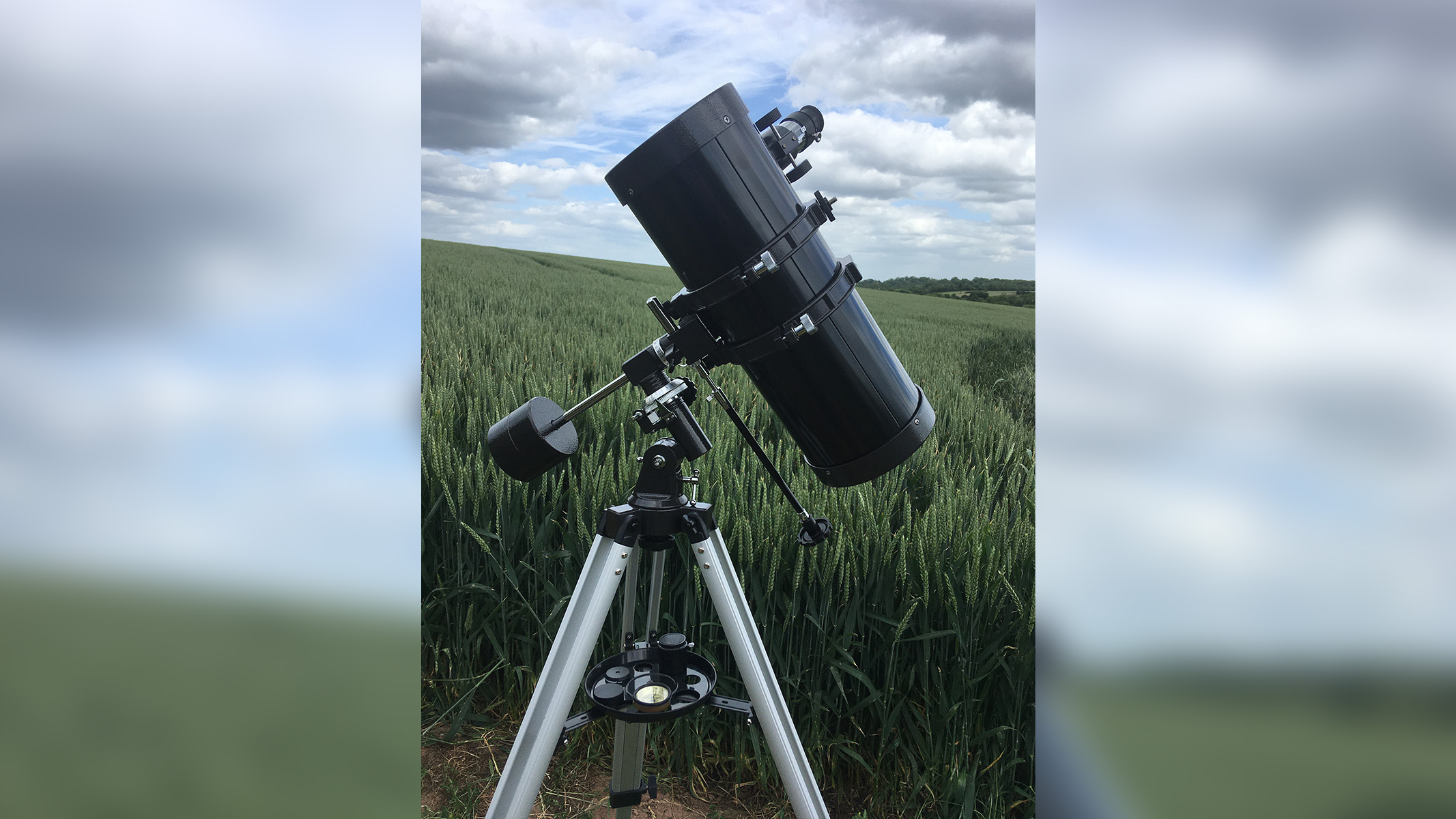
Best for versatility: Bundled with a free solar filter, this Celestron PowerSeeker 127EQi is suited to most purposes.
Specifications
Max magnification: 250x
Aperture: 127mm
Focal Length: 39-inches/1000 mm
Filter type: EclipSmart white light
Eyepieces included: 20mm erecting eyepiece, a 4mm high-power eyepiece, 3x Barlow lens.
Weight: 22lbs/10 kg (total kit)
Reasons to buy
+
German equatorial mount
+
Solid tripod
+
Good light gathering power
Reasons to avoid
–
Complex optics
–
Poor eyepieces
–
Cheap plastics
Buy it if
✅ You want a versatile scope: This is a great choice if you’re going to use it for multiple purposes.
✅ You’re looking for a reasonably priced scope: You can get cheaper, but this is still a good price considering how flexible the scope is.
Don’t buy it if:
❌ You don’t want to spend any more: While you can use this as is, to make the most out of it, you’ll want to spend more on additional eyepieces.
The bottom line
In this price range, the Celestron PowerSeeker 127EQ is hard to beat for its versatility, though you’ll need to buy extra eyepieces to really make the most out of this scope.
We had good things to say about this scope in our Celestron PowerSeeker 127EQ review. And as long as you make sure you buy the Celestron Powerseeker 127EQ with the free solar filter, you’ll find this is a pleasingly flexible scope. Only use this telescope for solar observation once you’ve attached the EclipSmart filter it ships with.
Its 5-inch aperture opens up the skies, day or night and, in theory, you can get a massive 750x with the provided Barlow lens. That said, we’d still recommend investing in the best telescope lenses to really make the most of this scope.
Celestron’s EclipSmart filter meets the ISO 12312-2 safety standard, so you can view upcoming eclipses in safety, then remove it to stargaze. It’s also a good idea to keep an eye on any children to make sure that little fingers don’t pull the filter off.
It boasts a well-engineered German equatorial mount, a serious improvement on the Celestron EclipSmart Travel Solar Scope 50’s slightly wobbly tripod, and it’s easy to assemble too. Solar and lunar eclipses aside, it’s also a capable scope for nature-watching.
- Back to the top ⤴
Best budget
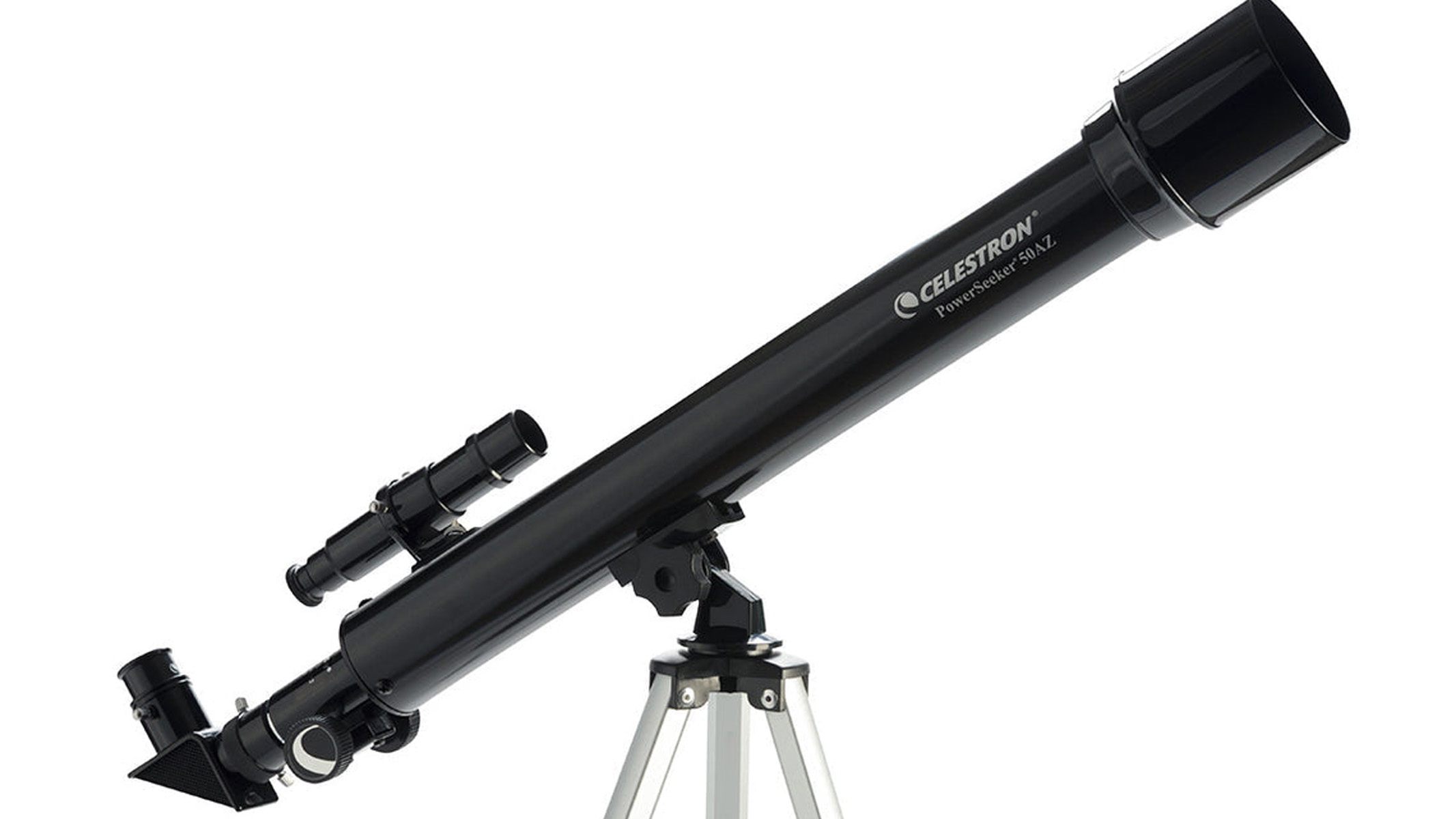
Celestron PowerSeeker 60AZ telescope with free EclipSmart solar filter
Best budget: Zoom in on the eclipse safelty with this budget scope, also suitable for wildlife-watch and astronomy.
Specifications
Max magnification: 142x
Aperture: 60mm / 2.4-inch
Focal length: 700mm / 28-inch
Filter type: EclipSmart white light
Eyepieces included: 20mm and 4mm, erect image star diagonal, Barlow Lens
Weight: 2.4 lbs / 1.09 kg all kit
Reasons to buy
+
Lightweight and convenient
+
Affordable price
+
Comes with free 36,000 object PC software.
Reasons to avoid
–
No lens caps
–
Some color fringing
–
Lack of brightness
Buy it if
✅ You don’t want to break the bank: This is an affordable way to watch the eclipse in safety, and it can be used for nature watching and stargazing too.
✅ You want portability: While this isn’t the smallest scope on this list, it’s still light enough to carry about with relative ease.
Don’t buy it if:
❌ You’re a serious sun-watcher: This is fine for beginners, but for astonishing views of the sun, consider investing in a solar telescope with an H-alpha filter.
The bottom line
🔎 The most affordable of all our solar scopes picks, the Celestron PowerSeeker 60AZ is a good choice for absolute beginners or those on a low budget.
Want to zoom in on the eclipse without spending a fortune? We think the Celestron PowerSeeker 60AZ with free solar filter is the best budget solar telescope. And, despite its low cost, it’s not a toy; it’s a step above Celestron’s entry-level scope, the 50AZ, and has enough power and versatility to become your go-to telescope. Remember, only use this telescope to look at the sun once you’ve attached the solar filter it comes with (also available to buy separately).
It’s easy to use, thanks to its alt-azimuth mount, making it ideal for beginners and children, as long as you make sure the solar filter is on before letting little eyes watch the eclipse.
It’s also compact and lightweight enough that you can pack it into your car or put it away if you do just want it for eclipse viewing. And if you do decide to use it for nighttime viewing, its 60mm aperture will drink in enough light for you to pick out stellar objects.
Those who’ve purchased this scope have been happy with it, describing it as “a great little scope” and a “fantastic entry-level scope”. A handful of people state that the tripod could be better, in line with our review of the Celestron EclipSmart Travel Solar Scope 50, but for this price the Celestron PowerSeeker 60AZ with free solar filter is worth picking up.
- Back to the top ⤴
Best premium
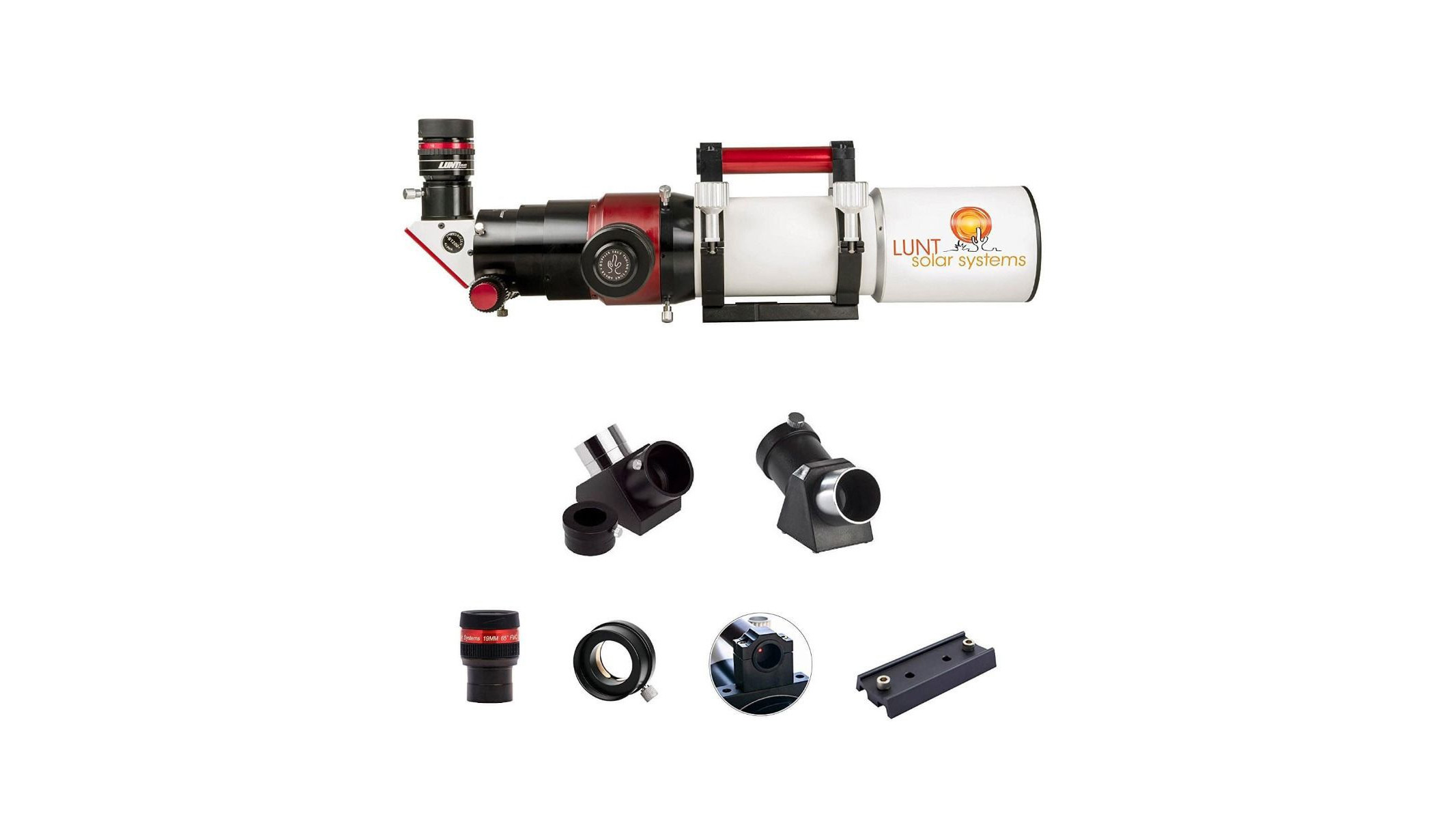
Lunt 80mm Universal Telescope
Best premium: A top tier premium telescope capable of delivering stunning views, at a price.
Specifications
Max magnification: 140x
Aperture: 80mm
Focal length: 560mm
Filter type: H-alpha
Eyepieces included: 1.25″ Nighttime Star Diagonal, 1.25″ Diagonal for Terrestrial observation, 19mm Flat Field Eyepiece
Weight: 9.25lbs / 4.2kg
Reasons to buy
+
Powerhouse of a telescope
+
Built to last
+
H-Alpha filter
Reasons to avoid
–
Doesn’t come with a tripod
–
Expensive price tag
Buy it if
✅ You want brilliant, close-up views of the sun: This telescope is a real powerhouse and its H-alpha filter lets you view the Sun’s Chromosphere
✅ You want a versatile scope: While Lunt specialises in solar scopes, this particular scope can also be used for night-time observation.
Don’t buy it if:
❌ You’re working to a budget: At over five thousand dollars this scope is not cheap, but you’re getting what you pay for.
The bottom line
🔎 This Lunt 80mm Universal Telescope is a premium telescope at a premium price, from a company who specialize in solar scopes. If you’re a serious sky watcher, with an eye on both the sun and the nighttime skies, this scope should more than deliver.
The Lunt 80mm Universal Telescope isn’t cheap, but there’s a reason for that. Lunt has a reputation for delivering quality scopes, crafted out of premium materials. This is, as one satisfied customer described it, “The Ferrari of telescopes.” It’s a true universal telescope, designed for ultimate performance during day and night. Beware that you need to set up the appropriate solar modules in order to observe the sun during the day.
Its H-alpha filter should afford you stunning views of the surface of the sun, including surface details like sunspots, solar pores and more. Lunt’s pressure-tuned system allows you to make tiny, tiny adjustments to bring images into focus. It’s also sturdily built, but still manages to be portable.
This scope’s user reviews are extremely positive, with one purchaser praising how it let them pick out individual solar filaments, something their previous scope had been unable to do. It’s worth noting that while there appears to be a delay on buying these scopes from Lunt, the Lunt 80mm Universal Telescope is in stock at Agena Astro.
It doesn’t come with a tripod, but if you’re spending this much on a telescope, it makes sense you’d want one of the best tripods.
- Back to the top ⤴
Best solar telescopes: Comparison
Swipe to scroll horizontally
|
Product |
Max magnification |
Aperture |
Focal length |
Filter type |
Eyepieces included |
Weight |
|---|---|---|---|---|---|---|
|
Sky-Watcher Heliostar 76mm Solar Telescope |
150x |
3-inches / 76mm |
25-inches / 630mm |
H-alpha |
20mm 70 Degree 1.25″ 32x magnification |
8.4 lbs (3.81kg) tube |
|
Celestron EclipSmart Travel Solar Scope 50 |
118x |
2-inches / 50mm |
14-inches / 360mm |
White light |
20mm (0.78-inch) Kellner (1.25-inch), 18x magnification |
2 lbs/918g (total kit) |
|
iOptron 80mm White Light Solar Scope |
189x |
3.15-inches / 80mm |
16-inches / 400mm |
SolarLite white light (removable) |
25mm (16X), 10mm (44X) |
3lbs / 1.4kg |
|
Celestron PowerSeeker 127EQ with free EclipSmart solar filter |
250x |
5-inches / 127mm |
39-inches / 1000 mm |
EclipSmart white light (removable) |
20mm erecting eyepiece, a 4mm high-power eyepiece, 3x Barlow lens. |
22lbs/10 kg (total kit) |
|
Celestron PowerSeeker 60AZ telescope with free EclipSmart solar filter |
142x |
2.4-inches / 60mm |
28-inches / 700mm |
EclipSmart white light (removable) |
20mm and 4mm, erect image star diagonal, Barlow Lens |
2.4 lbs / 1.09 kg all kit |
|
Lunt 80mm Universal Telescope |
140x |
3.1-inches / 80mm |
22-inches / 560mm |
H-alpha (removable) |
1.25″ Nighttime Star Diagonal, 1.25″ Diagonal for Terrestrial observation, 19mm Flat Field Eyepiece |
9.25lbs / 4.2kg |
Solar Telescope FAQ
How do I choose the right solar telescope for me?
To choose the right solar telescope you need to consider what you want to use it for and how much you’re willing to spend. If you want a solar telescope exclusively for watching eclipses you needn’t spend thousands of pounds. The Celestron EclipSmart Travel Solar Scope 50, for example, is a good option if you plan on packing away the scope after each eclipse.
If it’s versatility you’re after, a scope that can be used for day and nighttime viewing, then the PowerSeeker 127EQ telescope with free EclipSmart Solar Filter is a powerful but pocket-friendly purchase.
If you consider yourself a seasoned professional, and have the budget, the Lunt Solar 80mm f/7 Universal Day & Night Use Modular Telescope is the model to go for. It may be expensive, but it’s a super-powerful premium quality scope that should be with for years, and it doubles up as a night-time scope.
In short, if you’re only interested in eclipse-watching, you can spend less, but for serious solar viewing, you should lean towards the premium end of the market.
How is a solar telescope different from a normal telescope?
The fundamental difference between a normal telescope and a solar telescope is that the latter is equipped with a special filter, typically a white light or H-alpha filter, that blocks out harmful light and allows you to view the sun in safety. So if you’re looking directly at the sun during an eclipse, you’ll typically see an orange circle, slowly covered by a dark disc. More expensive solar telescopes may have other features that make them more suitable for solar observation, such as built-in chromatic aberration correction.
How is a white light filter different from an H-alpha filter?
To view the sun in safety you require, at minimum, a white light filter, which block out potentially harmful wavelengths of light. With sufficent magnification, it’ll allow you to see the sun’s visible photosphere, letting you pick up on solar spots and solar pores, which is still impressive to behold.
However, you can also get H-alpha filters which allow you to see into the chromosphere of the sun, offering you a more detailed look at our star. An H-alpha filter removes even more light than a white light filter, blocking out everything but the H-alpha wavelength band (656nm). That’s the wavelength emitted by hydrogen atoms, so you can see hydrogen emissions in the Sun’s chromosphere; solar flares, solar filaments and more.
So why wouldn’t you buy a solar scope with an H-alpha filter? Because they’re typically much more expensive than white light filters. It’s up to you to decide whether the additional solar spectacle is worth it.
How do you know a solar telescope is safe to use?
If you’re buying a solar telescope, you it’s important to buy a scope that meets the ISO 12312-2 safety standard. That means no more than 0.0032% of the sun’s dangerous rays meet your eyes. And while that number may not be stamped on the telescope itself, it should be somewhere on the packaging, product listing or both. If you don’t see the standard listed somewhere, you could be risking your eyesight.
How we test the best solar telescopes
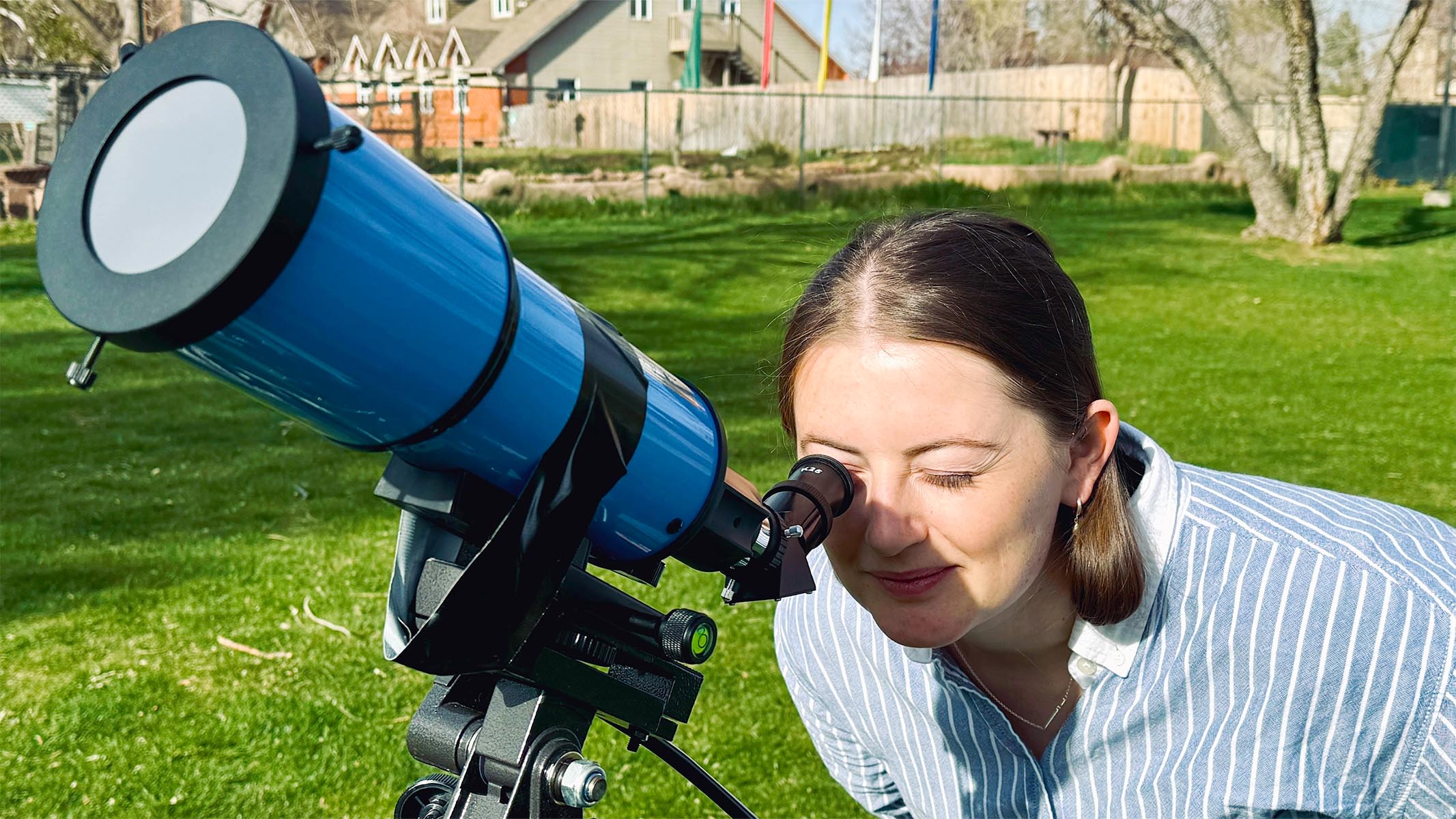
Our expert staff and reviewers have many years experience observing stars both during the day and at night. Each telescope is put through a rigorous review process where we assess its ability to perform basic functions, check its optical quality for distortions such as coma and chromatic aberrations and analyze features of importance, like the types of filters used and their safety.
Of course, observing the sun can be dangerous so we point out to never look directly at the sun without correct protection and filtration. Where telescopes require filters to be attached before daytime solar observation we point this out but also ask readers to check their own manual when setting up new solar telescopes, both for the first time and on subsequent uses.
Update log
Recent updates
Going forward this log will be used to record major updates to this page such as removal or addition of products, updates about celestial events and new technical information from our experts.
To guarantee you’re getting honest, up-to-date recommendations on the best solar viewing equipment to buy here at Space.com we make sure to put every product through a rigorous review to fully test. We consider each product based on numerous aspects, from its construction and design, to how well it functions as an optical instrument and its performance in the field.
Our expert staff and knowledgeable freelance contributors thoroughly test each product. This ensures honest reviewing based on the price, category and intended use.
With complete editorial independence, Space.com are here to ensure you get the best buying advice, whether you should purchase an instrument or not, making our buying guides and reviews reliable and transparent.
If this guide has inspired you to invest in some astronomy gear, check out the best telescopes, best binoculars and best cameras to get you started.
Join our Space Forums to keep talking space on the latest missions, night sky and more! And if you have a news tip, correction or comment, let us know at: community@space.com.
More about skywatching kit



